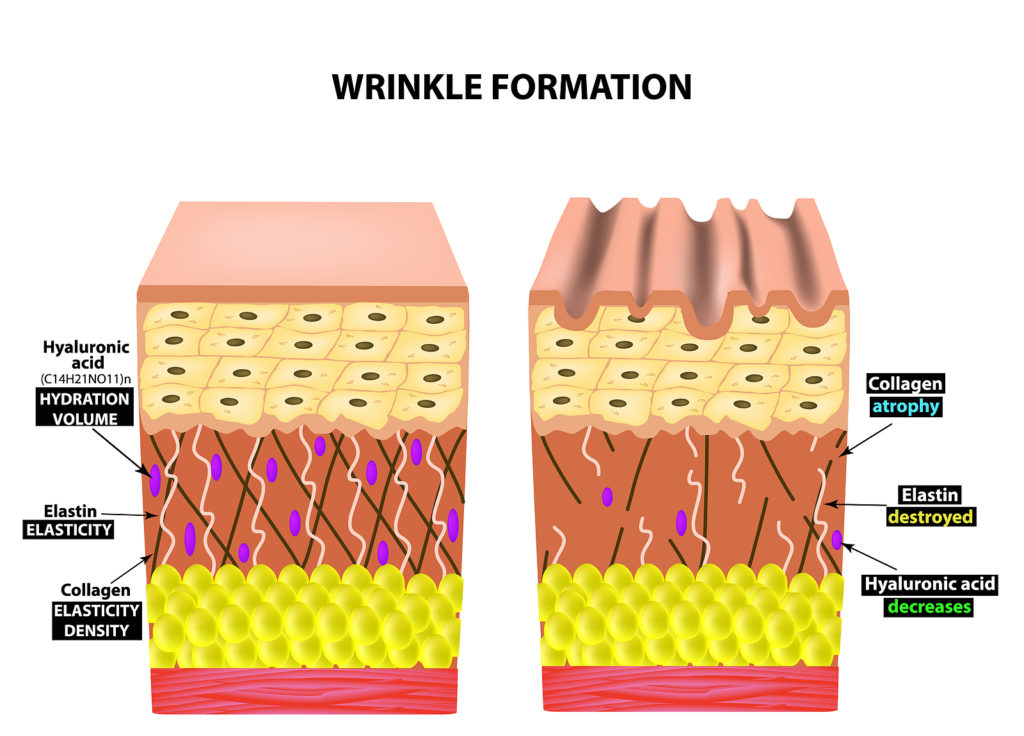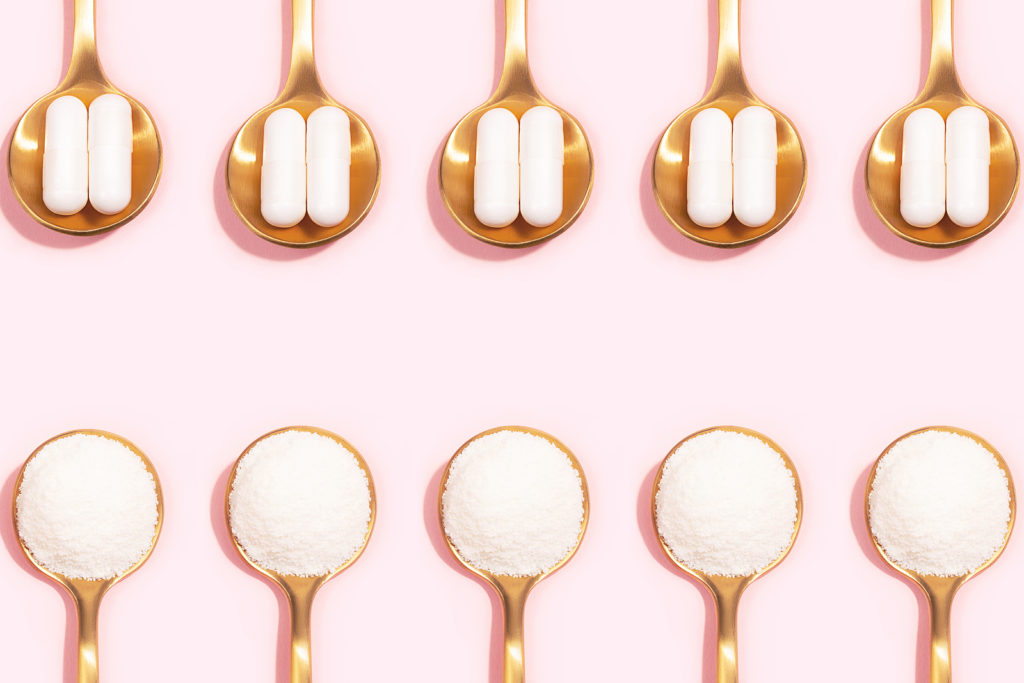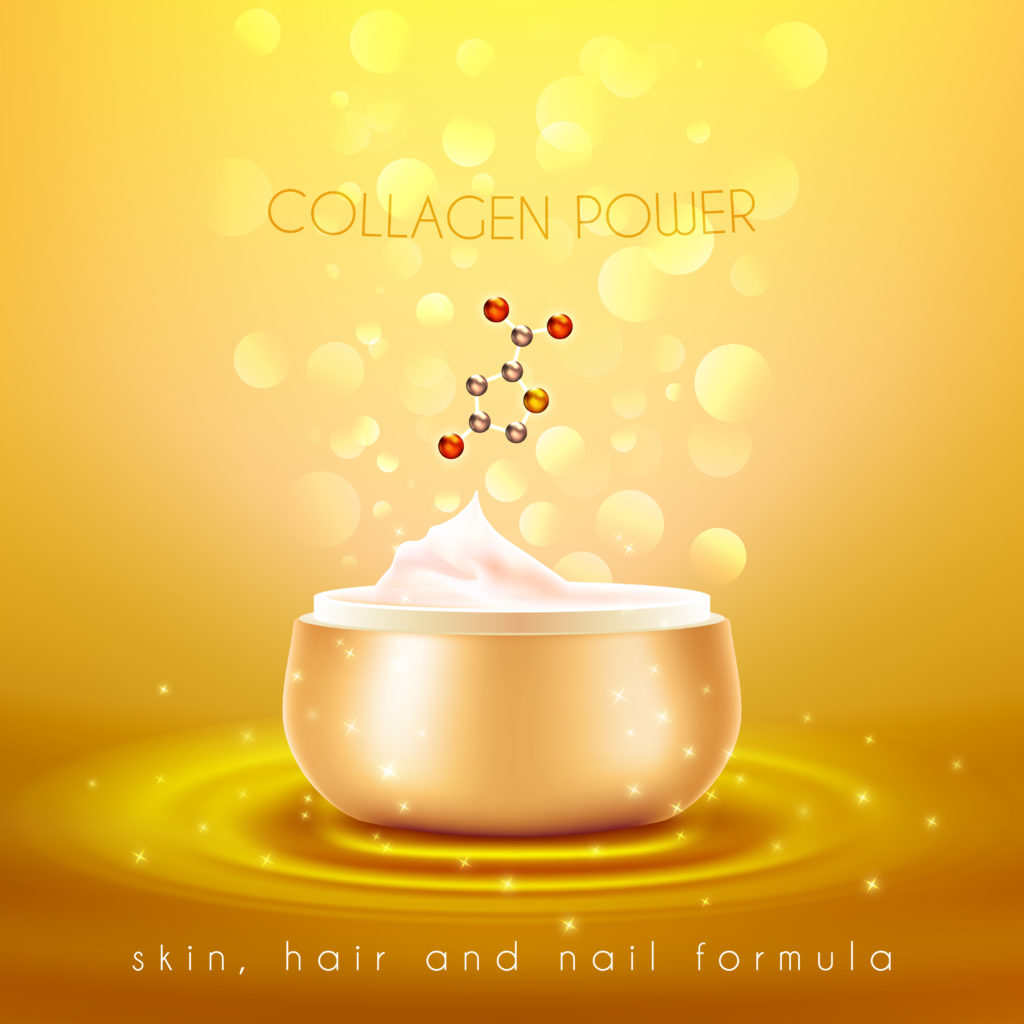Collagen Replenishment: Fighting Skin Ageing
If you’re anything like me, stepping into the skincare section of any proprietor can be an overwhelming experience. With so many products offering so many promises of capturing fast-fading youth, I’m yet to become loyal to any particular product… or to have much of a clue as to what is best. One thing I have become certain of, though, is that collagen has left a definite mark on the lotions and potions industry. There seems to be a good scientific rationale for this too: collagen makes up a huge portion of your skin (75-80%). Also, a decrease (and weakening) in collagen over time leads to the visible signs of ageing. But just how effective are collagen-containing products at halting or reversing these? Let’s dive (skin) deep.
Key points:
- Collagen is the primary structural protein of the skin. Loss of collagen contributes significantly to the ageing of skin.
- Many skincare products contain collagen hydrolysate, which is more readily absorbed than collagen. Hydrolysate derived from fish tissue appears to be more bioavailable than that from animal tissue. Less common sources include plant tissue and synthetic forms.
- Hydrolysate supplements have the potential to increase collagen density and counter the effects of aging on the skin. However, we cannot yet be certain of this, and more rigorous research is warranted.
- Creams and related beauty products containing hydrolysate offer some protective benefits, but will not restore collagen levels.
What is collagen?
Collagen is a protein. The most abundant one in our bodies, at that. It’s found not only in skin but other connective tissues i.e. in bone, cartilage, tendons. It has a number of important roles in the body: studies indicate it may protect against osteoporosis, osteoarthritis, oxidation and inflammation, tumours, atherosclerosis, obesity, high blood pressure, and aid in wound healing and lowering blood sugar.
But focusing on the skin… Collagen provides structure, tensile strength and stability. It is viscoelastic, meaning it both resists deforming forces and returns to its original shape after deformation. All collagen proteins have a regular, triple helix structure and cluster together to form long fibrils. These fibrils allow cells to anchor to each other, thus supporting skin integrity.
Collagen loss leads to skin aging

Like any protein within the living body, there is constant turnover of collagen, with fibres being simultaneously broken down and replenished. Unfortunately as we age and the body slows down, we deposit less collagen. There are also proteins that increase collagen breakdown (eg: matrix metalloproteins). The net result is that fibrils lose their strength and thickness, and wrinkles form. This process is accelerated by excess UV exposure and lifestyle factors (eg: diet, smoking).
Image credit: mikrostoker https://www.bigstockphoto.com/
Harnessing the power of collagen
There have been 28 different forms of collagen identified so far. They are grouped into eight families based on structure, pattern of bonds between peptides (subunits of proteins), and where in the body it’s found. There hasn’t been much scientific enquiry into which type/s are best for skin enhancement. However, the cosmetic industry most often uses Type 1 collagen as it doesn’t trigger the body’s immune response and seems useful in building tissue. Incidentally, 60-80% of the collagen in the skin is Type 1 (with type 3 lagging behind at 15-20%). Perhaps the abundance of Type 1 led to the assumption that it is the best option.
Collagen products may be slapped on the skin or taken down the gullet (or even taken intravenously). Technically, they actually contain collagen hydrolysate products- i.e. smaller peptides from broken down collagen. To produce this, gelatin is first hot-water extracted from a tissue, and then further broken down. Collagen hydrolysate is a more easily absorbed form.
The collagen hydrolysate may be extracted from animal tissues such as pig skin, bovine hide, bones. However, there have been some concerns about these sources: it’s difficult to ensure uniform quality of batches, and there may be risks of inflammation or disease transfection eg: of Bovine Spongiform Encephalopathy. It’s generally low in allergenicity, but long term use may cause a reaction.
Now other options for collagen sources are also available. For example, the bones, scales, skin, fins of fish and structural components of diverse other sea creatures are one option. Granted, these are still animal sources- but they contain almost no biological toxins & contaminants, elicit even lower inflammatory responses, and are more readily absorbed. They are also cost-efficient to produce. However, it is not very stable in heat.
There is also a synthetic protein called KOD. It contains 36 amino acids- much fewer than natural collagen, but they self-assemble into triple helices in mimicry of collagen structure. At last check, KOD is not yet in use in cosmetics.

Collagen hydrolysate may also be extracted from plants. Or recombinant technology can be used to get yeast, bacteria, mammalian cells, insects or plants to produce it. This latter option is not in common use though, due to practical considerations such as expense.
Supplements: regenerating collagen from the inside out?
When collagen hydrolysate is ingested, it is broken into more than 30 types of peptides (primarily dipeptides and tripeptides i.e. groups of 2-3 amino acids) which are detected in the bloodstream within 2 hours.
It appears that supplements not only increase the density of collagen in the skin, but also of hyaluronic acid and other structural proteins elastin and fibrillin. It is thought that it achieves this by increasing the number of fibroblasts (i.e. cells responsible for producing collagen). As well as promoting synthesis, supplements may reduce degradation.

A number of human studies have suggested oral supplements do improve skin health and appearance. For example, improved moisture content, pliability and elasticity, greater smoothness, fewer wrinkles, and less roughness have been reported- both by randomised controlled trials, as well as those that warrant skepticism due to very small size and/or possible placebo effects. One small randomised controlled trial supported the claims of improved elasticity, but challenged the claim of improved moisture. The possibility of increased delivery of blood to skin cells has been raised by a tiny study of 5, but needs more substantial exploration.
As a whole, the body of evidence has further weaknesses. For example, cosmetic companies have performed a decent amount of research, but the results are patented and cannot be scrutinised by the public- or independent scientists. Also, the studies we do have access to generally only examine groups of people of similar ages, geographical location and sex. As these variables can affect skin health, this undermines the generalisabilty of results.
In addition, it is quite an assumption to say that supplement contents will be preferentially delivered to the skin. Also, there is some argument that normal dietary habits can provide the amino acids needed for the body to synthesise collagen.
If we are to take an optimistic view of the evidence, the disparities between studies still mean we do not know what the optimal doses and durations of supplementation are.
Collagen containing skin care creams etc
Products containing hydrolysate appear to form a film over the skin, which can be a barrier to water loss. Animal studies have also shown they may be protective against UV damage.

Whole collagen will not penetrate through the epidermis into the dermis. Hydrolysates have slightly greater penetration ability. However, it doesn’t look like they do anything to replace collagen within the skin. What they can do is form a film over the skin, which acts as a barrier to water loss. Animal studies have also shown they may be protective against UV damage. Thus topical applications may have some benefits to the appearance of skin, but not those you might expect.
Image credit: Background vector created by macrovector – www.freepik.com
If interested in trying the power of collagen for yourself you can find several collagen supplements and topical applications here.
The Verdict
The jury is out on the value of collagen hydrolysate supplements. There is evidence to support their anti-aging effects, but it is by no means unequivocal… at least, not yet. Seeing as supplements aren’t directly delivered to the body but have to be broken down in the digestive system first, you may find you obtain the amino acids needed to synthesise collagen just as easily from the diet. Larger quality studies will help provide more certainty.
Creams and other topical applications seem to have no direct effect on the collagen content of your skin. They can provide other benefits, but I’d ask myself if they are the best value ways to obtain them.
What are your go-to skincare tips?
References
Avila Rodríguez, MI, Rodríguez Barroso, LG, Sánchez, ML. (2018) Collagen: A review on its sources and potential cosmetic applications. J Cosmet Dermatol. 17: 20– 26. https://doi-org.ezproxy.uow.edu.au/10.1111/jocd.12450
Jhawar, N., Wang, J.V., and Saedi, N. (2020) Oral collagen supplementation for skin aging: A fad or the future? J Cosmet Dermatol. 19: 910– 912. https://doi-org.ezproxy.uow.edu.au/10.1111/jocd.13096
Kwatra, B. (2020). Collagen Supplementation: Therapy for Skin Disorders: A Review. World Journal of Pharmaceutical Research. DOI: 10.20959/wjpr20205-17513
Sionkowska, A., Skrzyński, S., Śmiechowski, K., and Kołodziejczak, A. ( 2017) The review of versatile application of collagen. Polym. Adv. Technol., 28: 4– 9. doi: 10.1002/pat.3842.
Song, H., and Li, B. (2018) Beneficial Effects of Collagen Hydrolysate: A Review on Recent Developments. Biomed J Sci & Tech Res. DOI:10.26717/BJSTR.2017.01.00021
